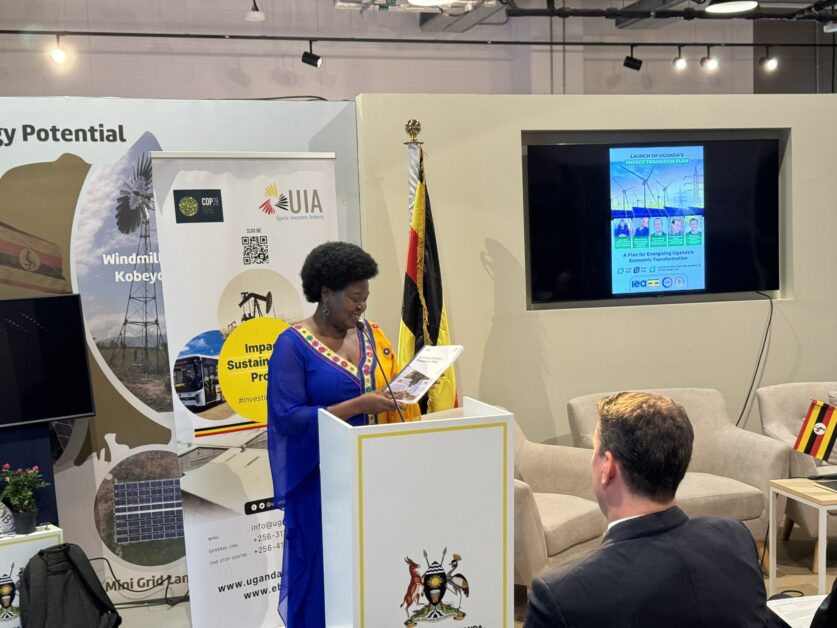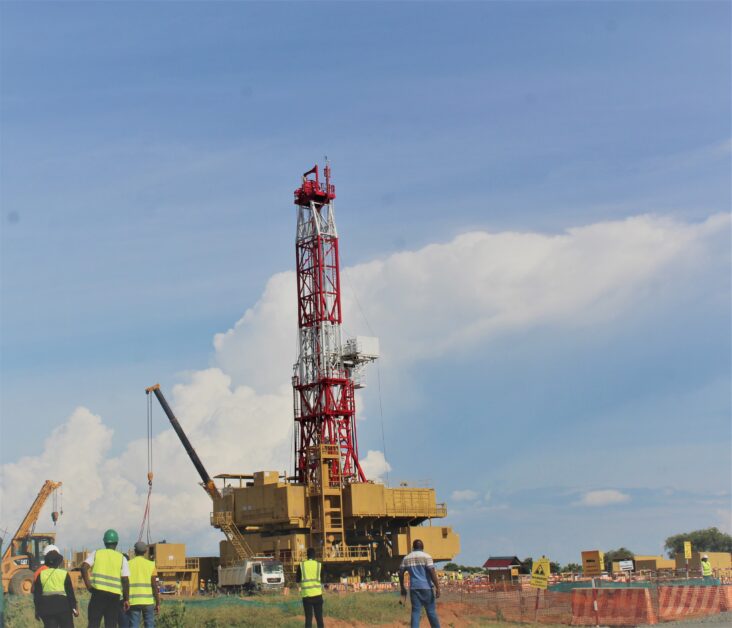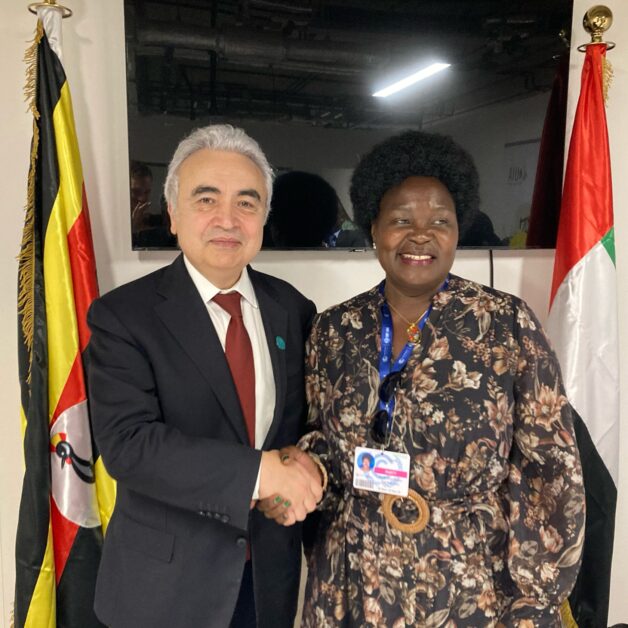This week, Energy Minister Ruth Nankabirwa led top Ugandan energy officials to unveil an ambitious energy transition plan at COP28 in Dubai.
The Energy Transition Plan (ETP) targets to ensure that 94% of the population will shift from biomass to renewables. The plan that has been developed in collaboration with the International Energy Agency (IEA) will implement the transition plan designed to reduce carbon emissions and contribute to renewable energy production such as solar and hydro, aiming to increase capacity to a staggering 52 GigaWatts by 2040.
The Plan, according to Nankabirwa, “charts an ambitious, yet feasible pathway to achieve universal access to modern energy and power the country’s economic transformation sustainably and securely”.
However, a crucial aspect of this transition plan is hinged on revenues from Uganda’s burgeoning oil and gas sector, whose commercial development is facing stiff resistance from gathering clouds of stubborn and increasingly powerful climate action forces.
“We have a unique opportunity to fund this transition through our natural resources, setting an example of responsible and sustainable development,” Nankabirwa insists.
With oil production set for 2025, the East African nation is among the major prospective oil producers that must balance her interests between fossil fuels, and embracing clean energy.
The COP28 President, Sultan al-Jaber in a press conference held on December 5th announced that the phasedown and phaseout of fossil fuels are inevitable and essential but the transition needs to be, “orderly, fair, just and responsible.”
A resilience test
Uganda is facing a resilience test in marketing her oil projects to potential financiers as the energy transition question gathers steam across the globe.
Chinese and African banks have offered to finance the construction of the East African Crude Oil Pipeline (EACOP) after much opposition and decampaigning from climate activists.
However, Uganda is yet to secure funding for her USD 4 billion oil refinery- which is closer to President Museveni’s heart- and yet – global financing institutions continue to cut back on funding oil projects over climatic concerns.
The planned oil pipeline will stretch across a distance of 1,443 kilometres from Hoima district in Uganda to Port Tanga in Tanzania.
Cost estimates for the pipeline stand between USD3.5- USD4 billion with 40 to 60 percent equity-to-debt ratio.
This implies close to USD2.4 billion (about UGX 9 trillion) will be secured as debt and USD1.6 billion in equity financing by shareholders. The shareholders include; Total Energies (62 percent), Uganda National Oil Company (15 percent), Tanzania Petroleum Development Corporation (15 percent) and China National Offshore Oil Corporation (8 percent).
Uganda will have a cumulative plateau production of 230,000 barrels per day under her two oil projects- Tilenga, operated by Total Energies, and Kingfisher, operated by CNOOC.
Growing civil society opposition
But, beyond the declining financing options, Uganda will have to address the concerns of a growing civil society opposing the oil project.
Vanessa Nakate, a dedicated subscriber to the #StopEACOP Movement is among other African climate justice activists demanding that International financial institutions publicly pledge not to provide the 60 percent debt financing towards the oil pipeline.

Nakate notes that fossil fuel companies are knowingly pursuing an “immoral business model” that has lethal consequences – particularly for those in vulnerable communities in the Global South.
“Fossil fuel companies should also be held accountable,” Nakate said while at the COP28 in Dubai, quoting a study showing oil companies owe USD209 billion a year for loss and damage they have caused, and could pay for this with their combined annual profits and still have profit left over.
Another Ugandan climate activist and lawyer, Dickens Kamugisha who heads the Africa Institute for Energy Governance (AFIEGO), in Uganda is on the frontlines advocating to stop the oil pipeline construction.
Kamugisha in a letter addressed to the International Union for Conservation for Nature (IUCN) noted that flaring oil will negatively impact nearly 2,000 square kilometres of protected wildlife habitats, not to mention IUCN-listed endangered species such as the Eastern Chimpanzee, Nahan’s Francolin, among other key species.
The threat of oil operations by Total Energies within Murchison Falls National Park- Uganda’s largest conservation remains a huge concern to environmentalists. It is the second-most visited national park and remains ecologically important for several globally and regionally threatened species.
It also comprises an array of protected sites throughout the region plus the forest reserves that form important animal corridors and represent biodiversity hotspot areas for tourism but are also of recreational importance.
Total Energies in its Environmental Social Impact Assessment indicates that the national park together with the adjacent Bugungu Wildlife Reserve and the Karuma Wildlife Reserve, forms part of the Murchison Falls Protection Area (MFPA).
The Murchison Falls Protection Area (MFPA) covers a Ramsar site, the Murchison Falls–Albert Delta Wetland System which was declared in 2006, consisting of the River Nile from the Murchison Falls up to and including a small part of Lake Albert. The park also has a key bird area with 451 bird species that are present ranging from the rare Shoe-bill stork to the Dwarf kingfisher and Goliath Heron, 76 species of mammals as well as Uganda’s largest population of the Nile crocodile. It is also home to the largest protected population of Rosthschild’s giraffes and the recovering population of 950 elephants.
For oil and gas extraction to occur in such conservation areas, large-scale infrastructure has to be constructed such as roads, oil pipelines, and buildings which can adversely affect important animal habitats, migratory pathways, and biodiversity, according to documented research by the World Wildlife Fund.
The fears from this research outline that oil activities could cause huge consequences such as loss of biodiversity, given the ecological sensitivity of the Albertine Graben. This could mean a higher risk of pollution, disrupting wildlife especially movements and mating partners due to habitat demolition, and extended environmental footprint due to paving roads and clearing drilling pads.

In fact, the Wildlife Fund research further shows oil spills could also occur from blowouts, pipeline leaks or failures, and accidents which pose a serious threat to ecosystems. Even so, oil and gas operations release tons of harmful pollutants into the air and sometimes discharge dangerous chemicals into the water, thereby degrading the clean air and water.
Total Energies indicates on its website that in 2012, it accepted the challenge of working in Uganda’s largest protected area – the Murchison Falls National Park. Despite the concerns being raised, the oil company spells out how it intends to use environmentally friendly technology within the park.
Total took on the task to develop oil resources within the park based on what it describes as; “Proven capability in developing oil resources in sensitive areas, and creating a project that shows how oil, environment and tourism can co-exist harmoniously.”
Mariam Nampeera, Total Energies’ General Manager says a biodiversity program set on four pillars such as working with Uganda Wildlife Authority will focus on reducing human pressures and strengthening the ecological resilience of the Murchison Falls Protected Area. The oil company is also working with the National Forestry Authority to roll out conservation and restoration measures for forests and their connectivity.
This will target the protection of 10,000 hectares of natural forest threatened with deforestation and the restoration of 1,000 hectares of tropical forest. The activities will include providing support to increase the protection of forest reserves, restoration of forest linkages along the Budongo – Bugoma corridor and roll-out of community conservation education programs,
“This partnership will mitigate the footprints of oil and gas [activities] by removing the carbon from the atmosphere and storing it, which is one of the nature solutions to mitigating the impact of climate change, which is at a broader global level,” Tom Okello Obong, NFA Executive Director, says.
Toughest moments
But even so, the toughest moment for Uganda has been the European Union’s parliament resolution, in which the parliament voted in September last year to stop the oil projects for at least one year. The resolution painted a gloomy future for the oil project showing that the extraction of oil in Uganda would (likely) generate up to 34 million tonnes of carbon emissions per year. The environmental cost of the emission of one tonne of carbon is about €180 (UGX 676,733), according to calculations published by Germany’s Federal Environment Agency (UBA).
Economic losses include crop losses, damage to buildings and infrastructure, and damage to human health.
This is against the International Energy Agency (IEA) warning in a 2021 report which shows that limiting global warming to 1.5 °C will prevent climate change’s most destructive impacts, and therefore requires new oil and gas development to stop immediately.

Uganda is a signatory of the Paris Agreement, committing to the goal of limiting the increase in the global average temperature to well below 2°C.
Uganda’s National Environmental Management Authority (NEMA) in a published statement notes that oil companies have mitigation measures in place to reduce the carbon footprint.
“Oil companies will focus on using the national grid power to meet the energy needs of the oil project, and offsetting residual emissions through tree planting projects,” the statement reads in part.
A few days after the EU parliament resolution was passed, Uganda Parliament’s Deputy Speaker, Thomas Tayebwa went on a diatribe, slamming the EU decision as a form of double standards in what he said was, “the highest form of economic racism against developing countries.”
Tayebwa presented an argument that various member states in the European Union continue exploring, developing, and have increased the production and use of fossil fuels in recent months.
Besides, there are more than 9,000 oil and gas production licences in the USA, including plans to drill in Alaska and the Arctic Sea.
The Deputy Speaker also draws parallels on the energy security question in which 53 licences have recently been issued in the North Sea and Germany has revived its coal plants.
“Is energy security a preserve for only the European Union? Does Uganda not have the same right?” he asked.
Uganda’s Energy Minister, Nankabirwa puts it another way, and subscribes to the view that, even as the threat of climate change looms in our backyards; developing countries must recognise that energy poverty could have far-reaching consequences.
Dr Joseph Kobusheshe, the Director of Environmental Health and Safety at the Petroleum Authority of Uganda unveiled Uganda’s Decarbonisation plan for the oil and gas projects at the #COP28.
Some of the controllable factors towards reducing the carbon footprint in Uganda’s oil and gas projects include process and design decisions such as recovery technology and facilities.
This therefore means forbidding routine flaring and venting of excess gas such as methane and carbon dioxide during oil operations, production outputs from the operations like converting excess gas into liquefied petroleum gas, and establishment of a robust leak detection system.
Alleged energy racism aside, according to Dr Kobusheshe, the Global Greenhouse Gas Emissions (GHG) Outlook shows current and historical emissions are highly unequally distributed, reflecting global patterns of inequality.
For instance, the G20 countries account for 76 percent of global emissions which increased by 1.2 per cent in 2022 averaging 7.9 tonnes of carbon, whereas least developed countries averaged 2.2 tonnes of carbon.
Kobusheshe argues that climate change affects different regions and countries differently and the capacity of each country to adapt or mitigate climate change varies.
This means, that as Uganda’s transition pathways get defined better, the sustainable use of the country’s oil and gas resources will play an important role in meeting the energy needs and achieving climate change goals.
Balancing between oil and renewable energy
Oil and gas will continue to serve a bigger share of the global energy needs for the next two decades up to 2045 as the world races towards net zero carbon emissions by 2050, according to the Organisation of the Petroleum Exporting Countries (OPEC) new World Oil Outlook.
Even though the share of oil in the energy mix declines modestly, it is envisaged to remain the fuel with the largest share between 2022 and 2045 at 30 per cent, closely followed by gas, coal, hydroelectricity, nuclear, biomass and other renewable energy sources.
Other renewables such as mainly solar, wind and geothermal energy are also expected to expand by 7.5 per cent per annum on average, significantly faster than any other source of energy.
The largest incremental demand over the forecast period is projected for the road transportation, petrochemical and aviation sectors.
Global oil demand is expected to increase by more than 16 million barrels per day. OPEC in its outlook shows the largest contributions to the oil demand increase are set to come from India, Other Asia, China, Africa and the Middle East excluding the Organisation for Economic Co-operation and Development (OECD) countries.
Concerning refined products, major long-term demand growth is expected for jet/kerosene at 4 million barrels per day (mb/d) followed by ethane/liquefied petroleum gas (3.6 mb/d), diesel/gas oil(3.1 mb/d), naphtha (2.5 mb/d) and gasoline (2.5 mb/d).
The growing demand for oil in the coming decades has a direct correlation with the growth of the global population, which is expected to expand by around 1.5 billion people from nearly eight billion in 2022 to about 9.5 billion by 2045.
This will be driven by strong population growth in the Middle East, Africa and Other Asia.
This growth in demand is partly fuelled by the world economy expected to almost double in size, and the global population to rise by 1.5 billion between now and 2045.
The OPEC outlook comes at a critical time when countries are ramping up licensing rounds for new oil blocks to source more oil and increase commercial production across Africa, Europe, the Middle East and the Americas.
It’s also a time when countries are required to show commitment to reducing their carbon footprints in line with the 2015 Paris Climate Agreement, which requires global warming to no more than 1.5 degrees Celsius.
OPEC Secretary General Haitham Al Ghais, while at the G20 Energy Ministerial Meeting in India last July indicated that in the decades ahead; “…what is clear is that the world will need more energy, as populations expand and economies grow.”
Mr Haitham argues that the oil industry alone requires global investments of USD12.1 trillion and [USD14 trillion] between now and 2045.
However, with increasing calls over the past few years to end financing of oil projects, OPEC believes….” this is neither pragmatic nor constructive for the way forward.”
“Following this path will severely affect economies, constrain social mobility, limit affordable energy access and exacerbate energy poverty,” Mr Haitham shares in his speech.
In fact, in his view, ensuring energy security and affordable access, while also lowering global emissions in line with the Paris Agreement, will require all energies, technologies, and unprecedented investment and collaboration.
Haitham notes that as oil-producing countries continue to invest in upstream and downstream capacity, they are also mobilising cleaner technologies to decarbonise the industry. This means they are making major investments in renewables and hydrogen capacity, carbon capture utilisation and storage and other technologies, as well as promoting the circular carbon economy.
OPEC believes the future needs to see investments and finance in energy transitions that focus on an inclusive ‘all-peoples, all-fuels and all-technologies’ approach.
Tom Ayebare Rukundo, the Petroleum Authority of Uganda’s Economic Analyst says growth in demand for oil and gas is largely driven by an increase in the global population and the related increase in economic activity around the globe. Therefore, Rukundo explains that whereas the world is pushing for cleaner sources of energy, the realisation of this ambition is slower than the actual energy demand and hence fossil fuels remain a cornerstone of the global energy mix.
In the Ugandan context, it confirms the strong economic prospects and bankability of Uganda’s oil sector as there will be global demand for crude beyond 2045, 20 years after First Oil in 2025.
“Furthermore, the country has the potential to be an industry leader in the region with enormous potential for all Ugandans,” Rukundo says.
However, Rukundo’s strategy to strike a balance must be tailored to where the countries’ are in regard to their National Determined Contributions (emission levels allocated per country) and the level of development.
“For countries like Uganda, the oil and gas resources should be used to enhance the reduction of greenhouse gas emissions through various initiatives such as the production of cheaper liquid petroleum gas to replace biomass across the country (such as charcoal),” Rukundo says.
Anthony Ogalo, the Sustainable Energies and Petroleum Association of Uganda’s General Manager is in agreement with other analysts, saying the energy demand is increasing at a higher rate than at which alternative cleaner energies are being developed forcing the world to rely more on oil and gas.
“With alternative cleaner innovations being slow, what fills the gap are fossil fuels, and this will continue to grow until such a time when alternative sources catch up,” Ogalo explains.
Ogalo adds that shareholders in the oil industry are excited by its profitability forcing them to push for more investments.
Ogalo suggests non-commercial investment in alternative energies until such a time when it makes commercial sense.
